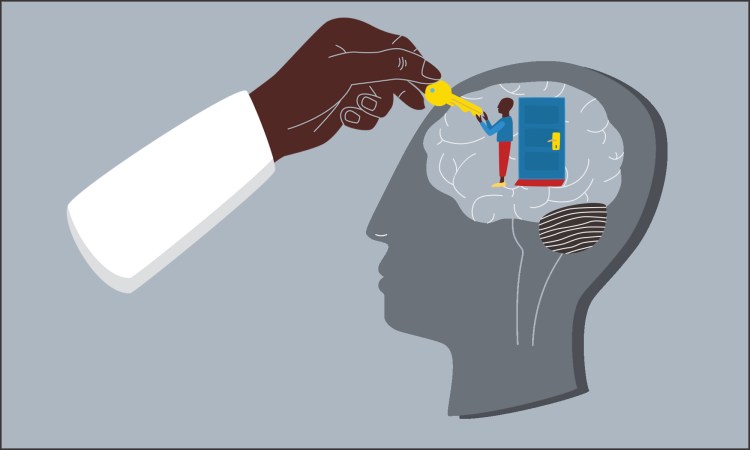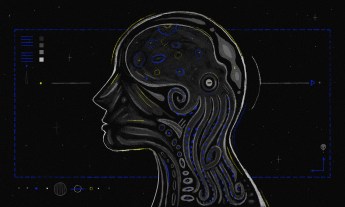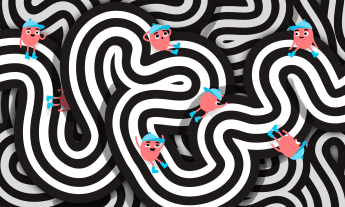
How many unresponsive patients actually have some consciousness of what’s occurring around them? Possibly up to 20 percent, according to neuroscientist Adrian Owen, who is determined to give them a voice.
In groundbreaking research, neuroscientist Adrian Owen (TEDxUWO Talk: The quest for consciousness) has found that a significant number of people in a vegetative state — what he calls the gray zone — are fully conscious, although they don’t visibly respond to any external cues. One of the techniques he’s developed involves placing unresponsive patients in an MRI scanner and asking them to imagine playing a game of tennis. In 15 to 20 percent of the people he has studied at Canada’s Western University, he has detected an unmistakable pattern of activity in the brain’s premotor cortex, the part that processes movement. Here, he shows us how he is now bringing his pioneering work into people’s homes.
One night in May 2010, a Canadian woman named Winifred suddenly woke up. Her husband, Leonard, was snoring beside her. He always snored, but somehow she knew he was in trouble. She tried to rouse him and when she couldn’t, she called out to her children. Her son dialed 911, and they lifted Leonard to the floor. This was not easy since he was a big man — in his youth, he was a sailor in Bombay.
Leonard had stopped breathing. Medics determined he was in the throes of a cardiac arrest, administered CPR and got his heart beating again. They rushed him to the local hospital in Ontario, Brantford General, where he was placed in a medically induced coma to protect his brain from further injury.
He underwent heart surgery to fix one artery that was completely blocked and another that was 80 percent obstructed. A day and a half later, he emerged from his coma and entered the gray zone. “The news is not good,” said the doctor. “Leonard’s brain is severely damaged. He’s in a vegetative state, and he’s probably not going to make it.”
Perhaps Winifred was connecting with some part of her husband that was unavailable to the rest of us.
Those events set Leonard and Winifred on a collision course with my team at the Brain and Mind Institute. At the institute, we study consciousness and cognition, in both healthy and brain-damaged patients, using a range of tools from the simple to the ultra-sophisticated. MRI technology — which is what we often use in our work — is expensive, and getting people into it is difficult. But then Damian Cruse, our electroencephalography (EEG) genius who is now at the UK’s University of Birmingham, had the brilliant idea of buying a Jeep to carry our portable EEG brain-imaging gear directly to patients. An EEG can detect consciousness — and it can be used, when possible, to communicate with unresponsive patients. With our “EEJeep,” we could visit patients in their homes, care facilities and hospitals. Its potential impact was huge, increasing our ability to study more patients with not only brain injury, but also neurodegenerative conditions such as Parkinson’s disease and Alzheimer’s disease, debilitating conditions that lead to incapacity of mind and body.
In 2015, Damian, research coordinator Laura Gonzalez-Lara, and I drove to Brantford, a pleasant city in southwest Ontario, to see Winifred and Leonard. I’d last seen them in my office months earlier. It always strikes me as incredible that people in the gray zone — nonresponsive as they are and highly dependent on their caregivers — can travel huge distances, go to the movies (with assistance), watch TV and sit at the family table at Thanksgiving. All the while, it’s never clear whether they are there.
In my office, the atmosphere was upbeat and frenetic. Winifred enthusiastically told me about Leonard. His bedsores had healed, and he was pleased to see me, she said. But my news for her was different — in my examination, we’d found no evidence that Leonard was aware of where he was, who he was, or anything else around him. Even imagining a game of tennis, our gold standard, had failed us. Despite his lying in an MRI scanner for more than two hours, his brain showed no signs of real life.
Winifred listened to what I said but was keen to add color to our observations. She said Leonard was more responsive and enjoying a day away from his usual routine. I’m not saying she was disingenuous. She was sincere, and she spent a lot more time with Leonard than we had. Perhaps she was connecting with some part of him that was unavailable to the rest of us. To determine if this was so, we’d have to get into his home — and his head.
It almost seemed as if Winifred were carrying Leonard’s consciousness, keeping it alive until such time that he could carry it himself.
That was how we found ourselves heading toward Brantford. We pulled up at the couple’s bungalow, and Winifred came out to greet us. Damian shuttled inside our portable EEG gear, and I wondered: would today be different?
Winifred told us the night before Leonard’s cardiac arrest they had been planning a trip to India to see his family. She asked her husband to drink water from a cup through a straw. “You have to sip it,” she scolded him. She gently rubbed his cheek and throat. “If you show me you can swallow, I’ll give you more. You have to show me. I’m trying to wake you up. One more sip and I’m done. I want to see you swallow.” Her energy was astounding. “Did you see that sigh?”
The question was aimed at me. I did see it, but was it a conscious response to his wife, or was it an automatic reaction that meant nothing? Watching her interact with Leonard, I questioned what makes a person a person. He was there, but some critical part of his being was not — not to me, anyway. But to Winifred, he was there. It almost seemed as if she were carrying his consciousness, keeping it alive until such time that he could carry it himself.
An EEG cap has 128 electrodes attached to bits of rubber mesh and looks like a big hairnet, and it would be placed on Leonard’s scalp. Each electrode has a wire, which is plugged into a device like a hi-fi amplifier. The amplifier is hooked into a laptop computer.
When neurons become active, or “fire,” they emit electrical activity — a tiny fluctuation in voltage that is detectable at the scalp. It’s generally not possible to measure the electrical activity of a single neuron unless you surgically implant electrodes into the brain. Neurons fire in bundles, however, and the overall voltage change produced by a group can be detected outside the skull. The signal has to be put through an amplifier to make sense, but it is detectable.
When we talk about a part of the brain becoming “active,” like when the premotor cortex lights up as a person imagines playing a game of tennis, that means many neurons in the region are firing more than they were before they started imagining playing tennis. We can detect this change in electrical activity with our EEG electrodes. However, the system isn’t perfect, because of the inverse problem — the signal arriving at an electrode could come from any combination of neurons firing. It might be from the neurons directly beneath the electrode or from other neurons. The number and combination of possible contributing neurons is virtually infinite, so it’s impossible to relate an EEG signal to a precise location in the brain. EEG is also limited because all the electrodes are attached to the scalp so most of the activity that can be detected is close to the brain’s surface.
When words are presented in pairs, the second word produces a bigger electrical blip in your brain if it is unrelated to the first, like if you heard the word “dog” after “chair.”
Damian fitted the EEG net onto Leonard’s head. “Okay, buddy, I’m going to put earphones in your ears,” he said to Leonard.
Damian plugged in the amplifier, flipped open his laptop and fired up the program, saying, “We all need to be quiet now to make sure that Leonard is not going to be distracted.”
Leonard sat quietly, seemingly listening to the sounds we piped through his headphones. We couldn’t hear what he was hearing, and we had no idea whether he could, either. We had to wait to see what the data told us.
What was being played was a cornucopia of words and phrases. The words were played in pairs — some were clearly related to each other, such as “table” and “chair”; others, like “dog” and “chair,” were disparate.
This is because of what’s known in EEG circles as N400. When words are presented in pairs, the second word produces a bigger electrical blip in your brain if it is unrelated to the first. Why this happens is not exactly clear, although we think it’s due to a psychological phenomenon known as priming. Priming is related to expectancy: when you hear “table,” your brain expects that the next word might be “chair” because “table” and “chair” are often heard together. In a sense, the brain is more surprised when “dog” is followed by “chair” than when “table” is followed by “chair,” and the surprise registers as a detectable change in brain activity.
That the same word can cause a difference in brain activity, depending on the word that came before it, means our brains have processed the relationship between the two words — our brains understand that “table” and “chair” are more closely related than “dog” and “chair.” Something similar happens when we hear a sentence like “The man drove to work in his potato.” It generates a bigger change in electrical activity than “The man drove to work in his car.” The power of an unexpected ending!
Leonard seemed to drift in and out of sleep, while a strange poem played through his headphones:
eagle-falcon; cheetah-trailer
crow-starling; iguana-sweater
basement-cellar; mandarin-fence
dagger-knife; leotards-camel
In addition to several hundred pairs of related and unrelated words, we played him short bursts of carefully controlled noise, like static from an old radio that leaps out between the stations as you turn the dial. By assessing whether the electrical activity was different for related and unrelated pairs of words and whether words produced a change that was different from signal-correlated noise, we hoped to discover what Leonard’s brain was capable of.
We each contain whole worlds inside our heads. And for the most part, those worlds are ours alone.
When we finished the EEG testing, Damian lifted the net off Leonard’s head. Leonard didn’t budge. He’d hardly moved the entire time. This was important: the less movement, the more likely we were to get good, clean data.
Damian packed up, and Winifred and I walked out to the EEJeep together. I noticed a gray convertible in the driveway. She said, “It was Leonard’s pride and joy. I still take him for a ride. I can see he enjoys it!”
She told me to let her know if she could do anything to help me with my research. “It’s been my passion since day one,” she said. “People like Leonard need a voice. If your tests aren’t getting something out of Leonard’s brain, you need to improve your tests!”
Her words echoed as we drove back. She reminded me that my work in gray-zone science was about affirming the value of every life. The quest to uncover the nature of consciousness inevitably returns to the many ways that each of us is unique. We each contain whole worlds inside our heads, worlds built on a lifetime of experience. And for the most part, those worlds are ours alone.
I couldn’t help but wonder: at what point on the trajectory from nothingness to full consciousness do you start to become yourself again?
A month or so later, I called Winifred after Laura and I had pored over the results of Leonard’s EEG.
“How’s Leonard doing?” I asked.
Winifred was as chirpy as ever. “He’s improving every day! He’s even making sounds to tell me that he’s feeling better than last week!”
I said, “That’s fantastic. Well, unfortunately, we don’t have anything new to tell you.”
We could find no evidence from Leonard’s EEG that his brain could tell the difference between words and nonword sounds. “I was really glad to see Leonard’s physical condition improving,” I said, trying to sound upbeat.
“You see!” Winifred exclaimed. “I told you that he was getting better and better every day!”
I promised to stay in touch and keep Leonard at the top of my list when I road-tested my next big idea. I couldn’t help but wonder whether she was right about Leonard. Perhaps he was gradually making his way back. But back to where? At what point on the trajectory from nothingness to full consciousness do you start to become yourself again? In my explorations into the gray zone, I’d encountered so many people like Leonard: there appeared to be something there, at least in the hearts and minds of those who loved them. Some part of them persisted, beyond the physicality of their bodies and brains. But what was it?
As Winifred said, we do need better tests. We have to keep refining our methods, discovering new ways to keep making contact. I found myself hoping that one day she would fulfill the promise she and Leonard had made to each other the fateful night when he tumbled into the gray zone. With his wife beside him, he would go to India, where he was born. Winifred would take her husband home.
Excerpted from the new book Into the Gray Zone: A Neuroscientist Explores the Border Between Life and Death by Adrian Owen. Published by Scribner, an imprint of Simon & Schuster, Inc. Copyright © 2017 Dr. Adrian Owen.












